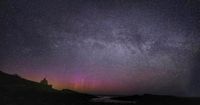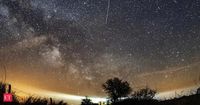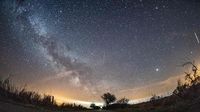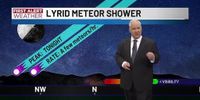The Lyrid meteor shower, one of the oldest known celestial events, is set to dazzle stargazers across the globe as it peaks from Monday night, April 21, into the early hours of Tuesday, April 22, 2025. Active since April 17, this annual phenomenon offers a spectacular display of shooting stars, with some estimates suggesting viewers could see up to 20 meteors per hour under optimal conditions.
According to the American Meteor Society, the Lyrids originate from Comet C/1861 G1 (Thatcher), which orbits the sun approximately every 415 years. As Earth passes through the debris trail left by this comet, tiny particles enter our atmosphere, creating the brilliant streaks of light known as meteors. Astronomer Dean Regas explains, "They heat up as they enter and burn away, leaving that brilliant streak." This meteor shower has been lighting up the night sky for over 2,700 years, with the first recorded observations dating back to 687 BC.
While the Lyrids are historically known for their reliability, this year’s viewing conditions may be affected by a waning crescent moon, which could make fainter meteors harder to spot. NASA’s meteoroid expert Dr. Bill Cooke advises that those in the Northern Hemisphere, particularly in areas with minimal light pollution, could still catch about five meteors per hour between 10 p.m. and 4:30 a.m. "The trick is patience," Cooke adds, emphasizing the need for viewers to allow their eyes to adjust to the dark and to avoid looking at their phones, as bright screens can kill night vision.
For the best viewing experience, experts recommend finding a dark location away from city lights. According to Professor Albert Zijlstra from The University of Manchester, the meteors appear to radiate from the star Vega in the constellation Lyra, making it easier for stargazers to locate the source of the display. "If you want to have a go, be outside at around 2 a.m. to 4 a.m., find a dark spot, take some 10-15 minutes for your eyes to get dark adjusted and look up," Zijlstra suggests.
The Lyrids are classified as a moderate meteor shower, with average rates of one meteor every five minutes. However, they are also known for rare surges, where up to 100 meteors can be seen in an hour, although these events occur roughly once every 60 years. This year, predictions indicate that the peak will be particularly favorable due to a lack of interference from the moon, allowing for clearer views.
Weather conditions will play a crucial role in the visibility of the Lyrids this year. The Met Office forecasts clear skies for large parts of the UK at around 3 a.m. on April 22, particularly in Northumberland, where dark skies are renowned for optimal stargazing. However, patchy cloud cover is expected in some northern areas, including parts of Scotland and Northern Ireland.
In the United States, weather forecasts indicate that storms may disrupt viewing in the eastern half of the country, with AccuWeather reporting that cloud cover could obscure the view for many observers. The best locations for witnessing the Lyrids this year are expected to be on the West Coast and in the Southwest, including central Texas, where conditions are likely to be clearer.
The Lyrid meteor shower is a reminder of the beauty and wonder of the cosmos, drawing in both seasoned astronomers and casual observers alike. As Earth travels through the remnants of Comet Thatcher, stargazers are encouraged to take a moment to appreciate the natural spectacle unfolding above them. With the right conditions and a little patience, the Lyrids promise a captivating display that connects us to the ancient traditions of skywatching that have captivated humanity for millennia.
As the Lyrids peak, many will gather in parks, backyards, and open fields, hoping to catch a glimpse of the fleeting meteors. Whether it's a solitary moment of reflection or a shared experience with family and friends, witnessing a meteor shower is a timeless activity that continues to inspire awe.
So, prepare your blankets, find a dark spot, and look up as the Lyrids light up the night sky this April. With each meteor streaking across the heavens, it’s a chance to connect with the universe and the wonders it holds.







